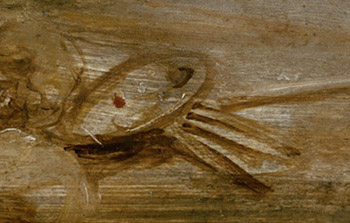
HOME |
STILL LIFES | FIGURATIVE | ILLUSTRATION | COPIES | INTAGLIO GEMS |
| Facebook Page | Biography | Resume | Contact | Links |
Research |
1400s-1700s drawing treatises online
Preparing
to draw (from 1400s-1700s treatises)
Hatching and shading (from 1400s-1700s treatises)
Roger de Piles on drawing technique (my
translation)
Jombert's
drawing treatise (excerpts in my translation)
Renaissance woodcut tools
Image
gallery
of my copies and reconstructions
| This information comes from restoration and
conservation articles
listed in the bibliography. Almost all these colours are
available through
historic pigments
suppliers (Kremer Pigments, Natural Pigments, Zecchi, Натуральные
пигменты, Рублёвская палитра, etc). Some like Natural Pigments
and Michael Harding even sell them in tubes. I make my own paint
and
work
with most of these colours
every day, and I would
encourage
any artist to give them a try. |
Synthetic:
lead white
(stack process),
vermilion
(dry
process), lead-tin yellow
(type I), verditer
(blue-green), Eschel
variety smalt
(blue and colourless kinds, latter sometimes used as an
additive in all colours), verdigris
(limited use),
(rarely mentioned: red lead / minium)
Minerals:
lazurite
/ natural ultramarine / lapis lazuli, azurite,
(rarely mentioned: malachite;
orpiment
(found in several very early
paintings done in Italy); quarz (mentioned only by Altamura, used as an
additive/siccative))
Earths:
yellow, brown and red-brown earths (including
hematite or hematite-containing earths),
umber;
Cassel / Cologne earth / Van
Dyck brown,
chalk
(calcium carbonate, fossil origin, sometimes added to
all
paints),
(rarely mentioned: asphaltum (Feller), green
earth (Von Sonnenburg))
Organic
origin: stil
de grain / schietgeel / brown pink
(buckthorn berry
yellow
lake), cochineal
lake, indigo
(usually in underpaint for lazurite), charcoal black (for
example in the
blueish-grey colour in flesh tones),
(rarely mentioned or
underidentified: madder lake, bone black, lamp
black)
Vehicles (medium):
linseed oil, walnut oil (often in whites, blues and light
colours)
turpentine,
pine resin (trace amounts often found in glazes, said to come from
turpentine); egg (white, yolk)
(detected in some
paintings)
panels: made of oak planks from circa 1.2cm (1610s) to 0.6cm (1630s) thick
covered by
calcium carbonate chalk in glue (gesso)
and a streaky priming
(imprimatura) of yellow or brown earths or/and charcoal black,
sometimes some lead white, in oil or in a medium containing egg,
possibly an egg-oil emulsion
canvas: usually tabby weave linen with a double oil priming: a yellowish or reddish thicker layer (yellow or red earths, chalk, sometimes small quatities of other pigments) covered with an opaque thinner grey or buff layer (lead white and charcoal black).

Altamura, Maria Luisa, ed. Marco Ciatti “La tecnica artistica di Rubens nelle due grandi tele degli Uffizi.“ Rubens agli Uffizi: il restauro delle Storie di Enrico IV. (Florence, Edifir, 2001), 49-59
Brown, Christopher. Rubens's Landscapes: Making and Meaning, London: National Gallery London, 1998.
Bruce-Gardiner, Robert and Helen Braham. “Rubens's Landscape by Moonlight”, The Burlington Magazine, vol. 130, no. 1025, (1988), 579-596.
Buck, Richard. “Rubens's The Gerbier Family; examination and treatment”, Studies in the History of Art (1973): 32-53.
Boersma, Annetje, Friso Lammertse and Alejandro Vergara. “Catalogue”, Peter Paul Rubens. The Life of Achilles, (Rotterdam: NAi Publishers, 2003).
Cardinali, Marco, Maria Beatrice De Ruggieri, Claudio Falcucci. "I dipinti di Rubens alla Vallicella: Studio della tecnica esecutiva" in La festa del colore: Rubens alla Chiesa Nuova, ed. Anna Gramiccia. (De Luca Editori d'Arte, 2005), 39-63.
Doherty, Tiarna, Mark Leonard and Jorgen Wadum. “Brueghel and Rubens at Work: Technique and the Practice of Collaboration”, Rubens and Brueghel a Working Friendship. (Los Angeles: The J. Paul Getty Museum and the Hague: Royal Picture Gallery Mauritshuis in association with Waanders Publishers, Zwolle, 2006), 215-251.
Feller, Robert L. “Rubens's The Gerbier Family; technical examination of the pigments and paint layers”, Studies in the History of Art (1973): 54-74
Fisher, Sarah. “The Finding of Erichthonius”, Allen Memorial Art Bulletin, vol. 38, no.1 (1980-1981): 21-37.
Fabian, Daniel. “Wan eim ein geschossener Pfeil im Lieb ist plieben”, Hommage à Paolo Cadorin; l’amour de l’art, (1999), 117-126.
Goetghebeur, Nicole; Guislain-Wittermann, Régine; and Masschelein-Kleiner, Liliane. "Painting Technique", Bulletin (Institut Royal du Patrimoine Artistique), vol. 24 no 182 (1992): 119-138.
Keith, Larry. “The Rubens Studio and the Drunken Silenius Supported by Satyrs”, National Gallery Technical Bulletin, vol. 20 (1999): 96-104.
Kirby, Joe. “The Painter’s Trade in the 17th Century,” National Gallery Technical Bulletin, vol. 20 (1999): 5-49.
Lammerste, Friso. “Small, larger, largest. The making of Peter Paul Rubens’s Life of Achilles”, Peter Paul Rubens. The Life of Achilles, (Rotterdam: NAi Publishers, 2003), 11-31.
Plesters, Joyce. “Samson and Delilah: Rubens and the Art and Craft of Painting on Panel”, National Gallery Technical Bulletin, vol. 7 (1983): 30-49.
Nykogosyan, Mariam. "Susanna and the Elders from the Rostov Regional Museum of Fine Arts; the lost painting of Rubens' studio?", VDR Beitrage zur Erhaltung von Kunst- und Kulturgut, (2005): 28-37.
Roy, Ashok. “Rubens’s Peace and War”, National Gallery Technical Bulletin, vol. 20 (1999): 89-95.
Saunders, Linnaea. “A Rubens Portrait Re-examined”, AIC Paintings Specialty Group Postprints, vol. 18 (Minneapolis: June 8-13, 2005), 76-83.
Stols-Witlox, Maartje, Tiarna Doherty and Barbara Schoonhoven. "Reconstructing seventeenth-centrury streaky imprimatura layers used on panel painting" inPreparation for Painting, the Artist's Choice and its Consequences. (London: Archetype Publications, 2008), 79-89.
Von Sonnenburg, Hubertus. “Rubens Bildaufbau und Technik II. Farbe und Auftragstechnik”, Maltechnik Restauro, vol. 85, issue 3 (1979), 181-203
Wadum, Jorgen. “Latest News from Paradise a Preliminary Attempt to Identify Rubens's Studio Practice, Part II”, Preprints of the ICOM Committee for Conservation 13th Triennial Meeting, (Rio de Janeiro, 22-27 September 2002), 473-448.
Wallert, Arie. Still Lifes: Techniques and Style, (Amsterdam: Rijksmuseum Amsterdam; in association with Waanders Publishers, Zwolle, 1999).
© Lala Ragimov 2009